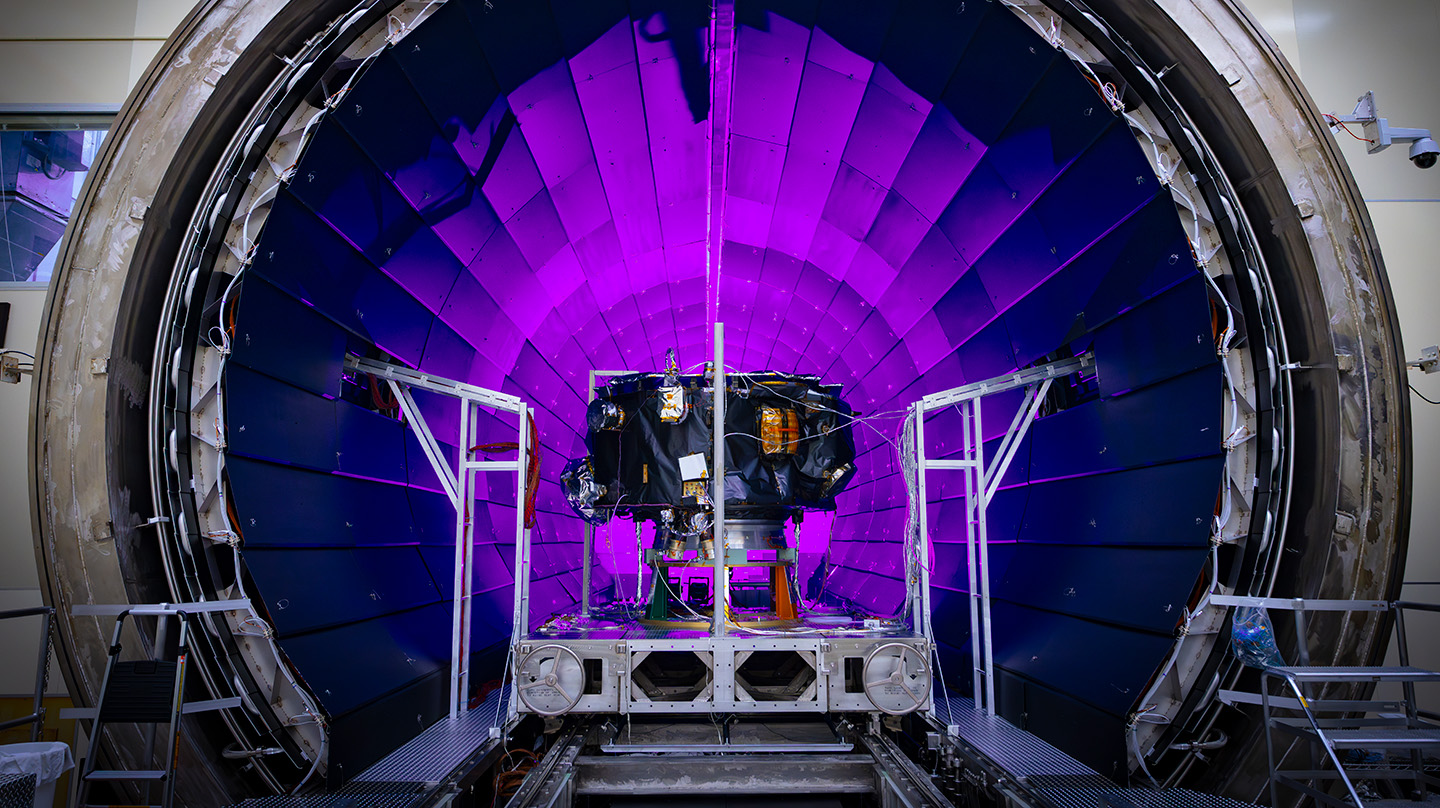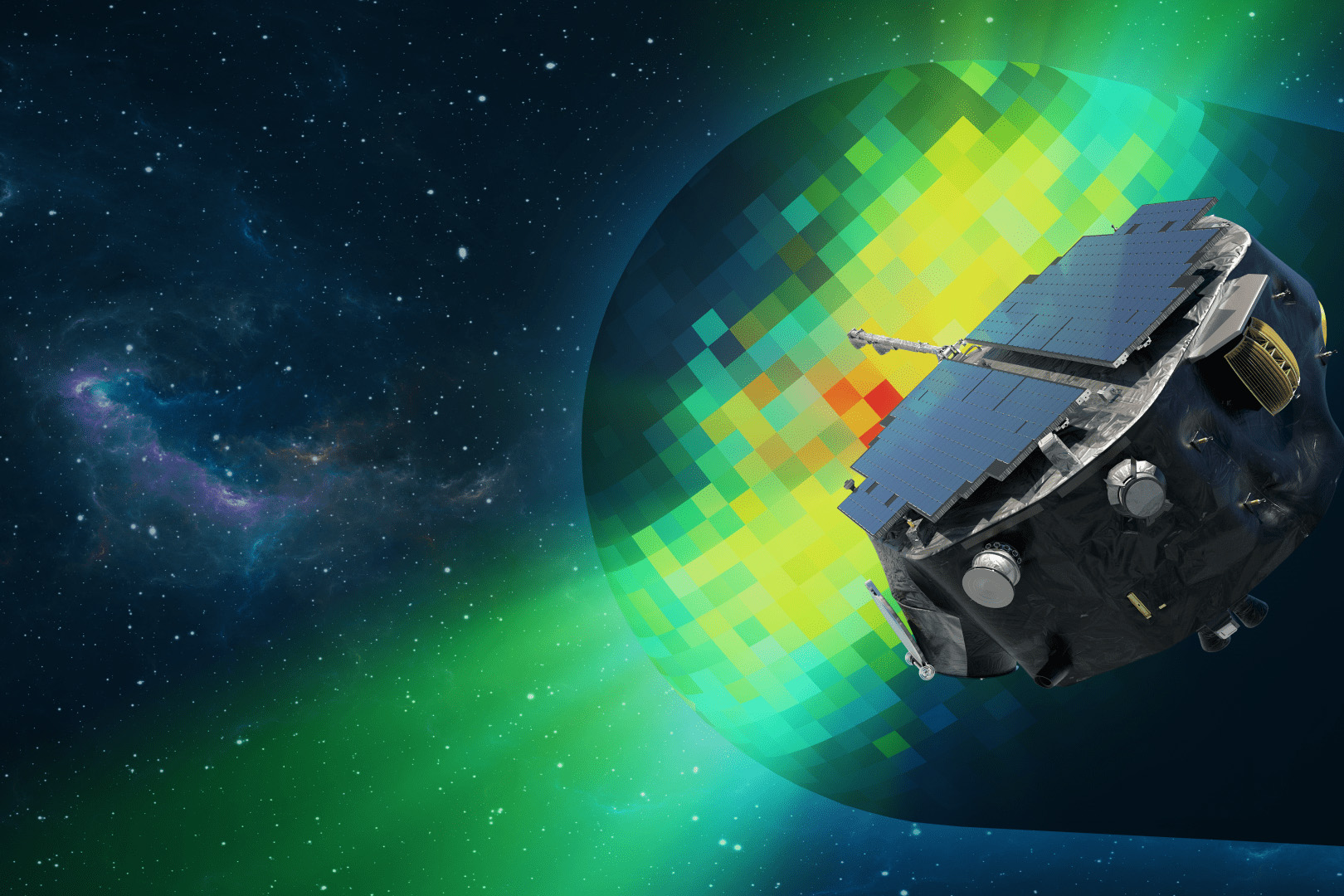Press Release
NASA’s IMAP Mission Passes Major Prelaunch Milestone

The Interstellar Mapping and Acceleration Probe (IMAP) is shown after installation in the X-Ray and Cryogenic Facility chamber at NASA’s Marshall Space Flight Center in Huntsville, Alabama.
Credit: NASA/Johns Hopkins APL/Princeton/Ed Whitman
Audio generated using AI voice technology.
Sept. 22 Update
- IMAP is now targeting a Sept. 24 launch date.
NASA’s Interstellar Mapping and Acceleration Probe (IMAP) completed its Flight Readiness Review on Sept. 18, which certifies its readiness to initiate final launch preparation activities. IMAP is targeting a launch date of Sept. 23 from Kennedy Space Center in Florida.
IMAP will study the heliosphere, the Sun’s magnetic bubble that shields our solar system from harsh cosmic radiation. With a suite of 10 instruments, the spacecraft will sample, analyze and map particles streaming toward Earth from both the Sun and local interstellar space to understand the size, shape and dynamics of the heliosphere’s boundary. Closer to home, IMAP will also provide enhanced information about space weather.
“With IMAP, we’ll push forward the boundaries of human knowledge and understanding of our place not only in the solar system, but our place in the galaxy as a whole,” said Patrick Koehn, IMAP program scientist at NASA Headquarters in Washington, in a NASA article. “As humanity expands and explores beyond Earth, missions like IMAP will add new pieces of the space weather puzzle that fills the space between Parker Solar Probe at the Sun and the Voyagers beyond the heliopause.”
Princeton University professor and principal investigator David J. McComas leads IMAP and its international team of more than 25 partner institutions. The Johns Hopkins Applied Physics Laboratory (APL) in Laurel, Maryland, developed and built the spacecraft and will operate the mission.
Exploring Our Solar Neighborhood
IMAP will travel to the first Sun-Earth Lagrange point (L1), which sits approximately 1 million miles (about 1.5 million kilometers) from Earth toward the Sun. From L1, IMAP will have an uninterrupted view of the Sun and activity at the interstellar boundary. IMAP is expected to arrive at L1 in January 2026.
The spacecraft will use several of its sensors on energetic neutral atoms (ENAs), which are created when charged particles mostly originating from the solar wind collide with neutral atoms near and outside the heliospheric boundary. During such collisions, some charged particles become neutral after “stealing” an electron from the atom, freeing themselves from magnetic fields and moving in a straight line back toward the spacecraft.
“We will be able to see the effects of these particles when they reach the outer heliosphere and how they interact with the interstellar medium to actually shape that heliospheric boundary,” said Matina Gkioulidou, IMAP project scientist at APL. Among the instruments studying ENAs is IMAP-Ultra, designed and built by APL.
ENAs and some interstellar material flow through the heliosphere from all directions, providing multiple opportunities for IMAP to measure and collect data on the origins and rapid movement of these particles. IMAP will also study interstellar dust and solar wind to provide a highly detailed, comprehensive map of the heliosphere.
“IMAP will help us determine the size and shape of our heliosphere and how it changes, and we can then compare these characteristics to those of similar astrospheres,” said Drew Turner, deputy project scientist for IMAP at APL.
Deeper Space Weather Knowledge
IMAP will also provide critical data for researchers tracking space weather, and how solar activity impacts Earth. Humans typically witness examples of space weather through the auroras at our planet’s poles, but as our society becomes more reliant on technology, space weather can potentially impact satellites in space, electronics both on and above Earth, and astronauts in space.
“The IMAP mission will provide very important information for deep space travel, where astronauts will be directly exposed to the dangers of the solar wind,” McComas said.
Mission data on the solar wind and the Sun’s magnetic field will support the IMAP Active Link for Real Time (I-ALiRT) system, which can then broadcast more frequent and reliable inputs to space weather models to improve predictions and warnings.
“Humans are affected by what’s happening near Earth and around our solar system,” said Gkioulidou. “IMAP will study that space environment — our solar neighborhood — in great detail to help us understand our home in the galaxy.”
IMAP is the fifth mission in NASA’s Solar Terrestrial Probes (STP) Program portfolio. The Explorers and Heliophysics Projects Division at Goddard Space Flight Center manages the STP Program for the Heliophysics Division of NASA’s Science Mission Directorate. NASA’s Launch Services Program, based at NASA Kennedy, manages the launch service for the mission.
Related Mission and Instrument

IMAP Interstellar Medium

IMAP-Ultra Interstellar Medium
Areas of Impact
Mission Area
The Applied Physics Laboratory, a not-for-profit division of The Johns Hopkins University, meets critical national challenges through the innovative application of science and technology. For more information, visit www.jhuapl.edu.